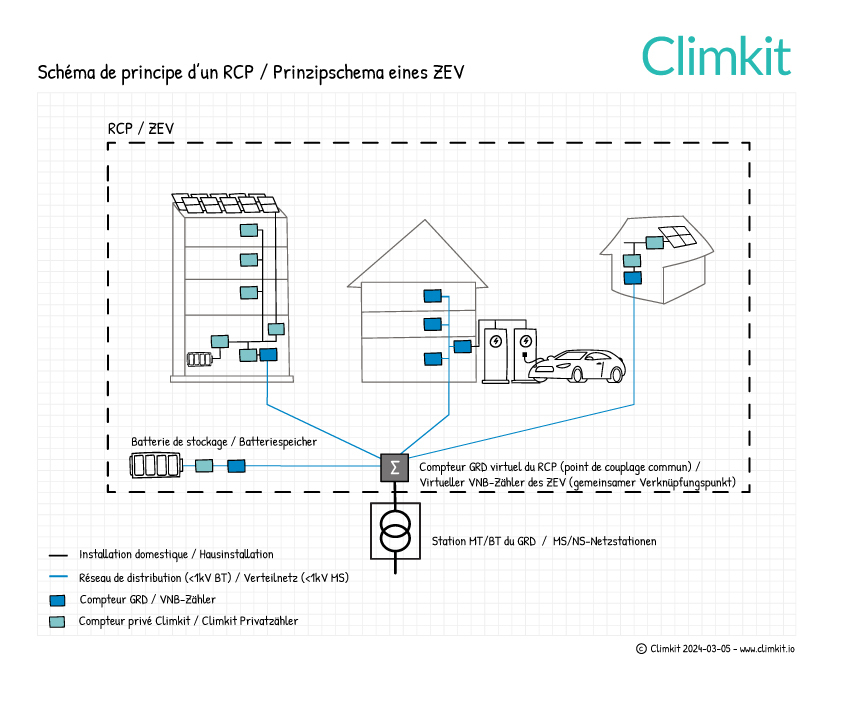Setting up an RCP
 Updated
by Nicolas Vodoz
Updated
by Nicolas Vodoz
Definition and General Operation
Since 2018, with the entry into force of the revision of the Energy Act (LEne), it has been possible to create Self-Consumption Producer Groups (RCP) in Switzerland. An RCP allows several end consumers of electricity to unite into a single consumer and customer from the perspective of the distribution system operator (DSO), with the aim of consuming shared photovoltaic electricity production, for example, generated on the roof of their building.
An RCP is traditionally established within a single building, with a single DSO meter installed at the electrical service entrance of the building. The Owner or the homeowners' association (PPE) then becomes the electricity supplier for the residents, who waive their basic supply from the DSO. Named as the RCP manager, the Owner then mandates a company, such as Climkit, for metering management and invoicing within the RCP.
Since January 1, 2025, it has been possible to establish an RCP involving neighboring buildings by using the distribution network to exchange the solar electricity produced. In this case, the DSO creates a virtual meter which results from the sum of the DSO meters installed in each building, thereby enabling the issuance of a single invoice. This is referred to as a virtual RCP. Apart from these differences in general metering, the rules for establishment and operation are the same, whether an RCP consists of one or several buildings.
The RCP is considered a single customer, and its manager is the sole contact person vis-à-vis the DSO, which invoices the electricity drawn by the RCP and remunerates the surplus solar fed back at the feed-in tariff. If several DSO meters are used for metering, the costs for the use and maintenance of these meters are also invoiced to the RCP.

Conditions for Implementation
The following conditions must be met to implement an RCP:
- The total photovoltaic (PV) power must correspond to at least 10 % of the grid connection power. For example, a building with a 125 A connection must be equipped with a PV installation of at least 8.7 kWp, which is approximately twenty photovoltaic panels.
- If the RCP is established in an existing building, the written consent of the residents interested in joining the RCP is required.
- If the RCP is constituted between several buildings, these must be connected to the same low-voltage coupling point (<1 kVA).
Implementation Steps
1. Initial Check with the DSO
If several buildings are involved, it is necessary to consult the DSO by communicating the address of the main building, for example, the one where a new photovoltaic system is planned to be installed. The DSO should be asked to identify neighboring buildings that can participate in the RCP. This request can be made by any interested party. The DSO will reply within 14 days with a list of eligible buildings based on the electrical network topology.
2. Application for Establishment and Designation of the Manager
The application for the establishment of the RCP is made by the electrician mandated by the Owner during the connection request for the building or the production installation via the dedicated form provided by the DSO and signed by all future members of the RCP.
A manager and contact person for the RCP vis-à-vis the DSO must also be designated. This is generally the Owner or the PPE. If the RCP consists of several buildings owned by different Owners, they must agree to designate one. This is usually the one with the main PV installation who seeks to sell its production to the residents of neighboring buildings with this extended RCP. It is recommended to establish an agreement between the Owners on how the RCP will be operated.
The DSO then has three months to examine the application. Residents who do not wish to join the RCP remain customers of the DSO, and the DSO will deduct their consumption from the DSO's overall invoice without needing to modify the wiring. Once this person leaves the building, their apartment can easily be integrated into the RCP.
In an existing building
If the RCP is established in a building with existing leases, it is essential to obtain the consent of each tenant. In the case of a PPE, the consent of each co-owner is necessary. The letter template below can be used to inform the residents and obtain their consent for the creation of an RCP:
In a new building
If the premises are vacant at the time the RCP is established (e.g., during a move or in the case of a new building), the Owner can require new tenants to join the RCP. This obligation can be integrated into the lease agreement or stipulated in a separate electricity supply contract.
Residential Lease Clause for RCP
The Landlord acts as the representative of the Self-Consumption Producer Group (RCP), responsible for the electricity supply, metering, and invoicing of the tenants. The costs attributable to the tenant are as follows: Costs for electricity drawn from the grid
- Costs for self-consumed solar electricity
- Costs for individual meters
- Costs for management (meter reading, administration, and invoicing)
The Landlord may subcontract the management of the RCP to a third-party provider. In all cases, the Landlord cannot be held liable in the event of an interruption of electricity supply from the grid (blackout) or from the photovoltaic installation.
3. Metering System Planning
DSO meters can be used for internal RCP metering, even if consumers have waived their individual connection. Due to the high monthly cost of DSO meters (CHF 6 to 10 per month), it is advisable to limit them as much as possible, especially at building service entrances, and to favor the installation of private meters to measure internal consumption (apartments and common areas) as well as the production of the various photovoltaic installations.
Furthermore, private meters offer significant advantages: in case of failure or metering dispute, the Owner can directly contact an independent electrician without depending on the DSO. Moreover, unlike DSO meters which only transmit data once a day, private meters can allow for real-time monitoring, essential for adjusting consumption habits and optimizing the use of solar production.
The planning of the metering system is a crucial aspect that requires careful evaluation of the situation, taking into account the one-time installation costs and the recurring costs that will be borne by the Owner and consumers during the operation phase. All these elements must be determined by the Owner and their mandated parties, engineers, and electricians, before the start of the installation work.
4. Installation and Commissioning
The installer proceeds with the installation of the photovoltaic panels and modifications to the metering system, including the removal of the DSO meters, the installation of new private meters, as well as the eventual preparation of the locations for the input and production DSO meters.
DSO Meter Data Retrieval
To manage the RCP, if multiple DSO meters are retained, Climkit will need their readings in the same way it collects data from private meters. Climkit therefore coordinates with the DSO to organize the daily and digital transfer (via FTP) of DSO meter data in the standardized SDAT-CH (Ebix) format to the Climkit platform. A flat fee is charged based on the number of meters for this integration.
5. Administrative Setup
Climkit contacts the Owner responsible for the RCP to establish the management contract and settle the administrative arrangements necessary for the operation of the RCP, such as defining billing rates and the list of members. The Owner also signs a power of attorney authorizing the DSO to send its invoice directly to Climkit.
6. Operational Phase
The RCP then moves into operation, and Climkit manages the RCP by generating individual consumer statements based on their consumption recorded from private meters and DSO meters. For each consumer, the share of electricity coming from the photovoltaic installation is distinguished from that coming from the grid.
If the Owner has opted for the full operating method, Climkit invoices consumers directly and manages payments. Thanks to the power of attorney signed with the DSO, Climkit periodically receives and pays the invoice related to the electricity drawn by the RCP. Once a year, a statement is established in favor of the RCP manager to attribute the income related to the sale of solar electricity.
If several photovoltaic installations belonging to different Owners are part of the RCP, the annual statement clearly details the production of each installation, allowing the revenue to be distributed among the Owners according to their own agreement.
